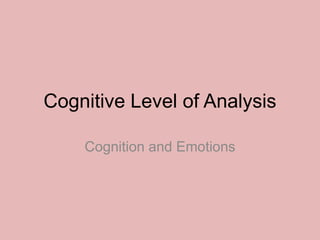
Cognitive Level of Analysis: Cognition and Emotion
- 1. Cognitive Level of Analysis Cognition and Emotions
- 2. Emotions • Three components of emotions: – Physiological changes • i.e. arousal of the autonomic nervous system and the endocrine system (unconscious changes) – Subjective feelings • i.e. what the person actually feels • happiness, sadness, etc – Associated behavior • i.e. smiling, running away, etc
- 3. Emotions • Serve as a guide to evaluate how important situations are • Not necessarily a conscious process • Cognitive appraisal is simply an interpretation which results in fight or flight • Fight or flight: physiological response which prepares the individual for direct action to confront or avoid danger and a cognitive appraisal of the arousal – Cognitive appraisal: decision about what to do based on previous experiences
- 4. Biological Factors in Emotion • Amygdala seems critical in the brain’s emotional circuit – May play a critical role in emotional memories • LeDoux describes two biological pathways of emotions in the brain – Short Route • From thalamus amygdala – Long Route • Neocortex (sensory cortex) hippocampus amygdala
- 5. LeDoux’s Emotional Pathways Neocortex/ Sensory Cortex Hippocampus Sensory Thalamus Amygdala Emotional Stimulus Emotional Response Long route Short route
- 6. LeDoux’s Emotional Pathways • Amygdala receives input from sensory processing areas in the neocortex and thalamus • Projects these to areas in the brainstem that control systems like fight or flight • Connections between the different brain structures allow: – The Amygdala to transform sensory info into emotional signals – The initiation and control of emotional responses
- 7. LeDoux’s Emotional Pathways • Advantageous to have both pathways because it allows us to be flexible in our responses! • For danger, the fast and direct pathway is best • The long pathway allows for a more thorough evaluation of a situation – Helps us avoid inappropriate responses to situations
- 8. Appraisal • Appraisals = Evaluations related to how the situation will impact one’s well-being – According to Lazarus • Positive emotions emerge if the appraisal assesses potential benefit & negative for potential harm • An important part of people’s reaction to emotional stress • People aren’t passive; they actively interpret and evaluate the world around them
- 9. Lazarus and Folkman (1984) • An individual’s experience of stress can be moderated by a number of factors – i.e. appraisal of threat, appraisal of one’s own resources for dealing with stress, etc – Influenced by personal factors like motivation, beliefs, and environmental factors
- 10. Stress Strategies • Problem-focused coping: Change the problematic situation that causes emotional stress • Emotion-focused coping: handle the emotions rather than change the problematic situation – i.e. escape, self-control, seeking social support, reappraisal
- 11. Speisman et al. (1964) • Same video of unpleasant genital surgery • 1 with gruesome commentary, 1 with happy commentary, 1 with intellectual commentary • Participants reacted more emotionally to the gruesome/traumatic video • Individual’s interpretation or appraisal of the event is more important than the events themselves
- 12. Speisman et al. (1964) • Issues of artificiality – It was conducted in a laboratory – Deliberate deception and unpleasant situations = questionable ethics
- 13. The Flashbulb Theory • (Brown and Kulik 1977) • A special kind of emotional memory which refers to vivid and detailed memories of highly emotional events that appear to be recorded in the brain as though with the help of a camera’s flash
- 14. Brown and Kulik • Suggested there may be a special neural mechanism which triggers an emotional arousal because the event is unexpected or extremely important • It is supported by modern neuroscience – Emotional events are better remembered than less emotional events
- 15. Neisser (1982) • Questions the Flashbulb Memory Theory: – People don’t always know the event is important until later • Memories are vivid because the event is rehearsed/reconsidered after the event – The flashbulb memories are governed by a storytelling schema following a specific structure • i.e. Where were we? What we were doing? Who told us? How did we feel? Etc.
- 16. Neisser and Harsh (1992) / Talarico and Rubin (2003) • Neisser and Harsh (1992) – Interviewed witnesses of Challenger Space Shuttle tragedy 24 hours after and 2 years after – Participants were confident in their accuracy, but 40% of participants had distorted memories • Talarico and Rubin (2003) – Emotional intensity was often associated with greater memory confidence, but not with accuracy
- 17. Breckler (1994) / Holmberg and Holmes (1994) • Breckler (1994): – People’s current attitudes about blood donation impacted their memories about how they felt when they donated blood in the past • Holmberg and Holmes (1994): – Men whose marriages became less happy overtime tended to recall early interactions in the marriage as being more negative than they had originally reported
